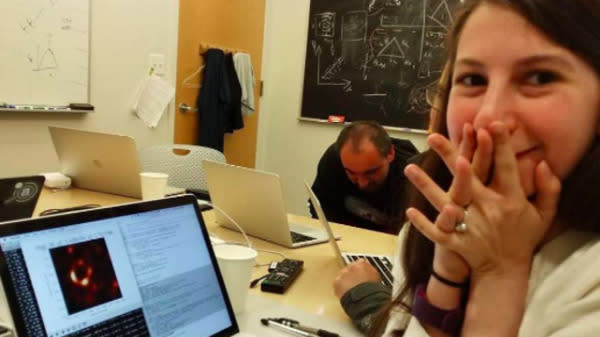Photo Of Scientist Creating Her Historic Black Hole Image Goes Viral

For the first time in the history of humanity, people around the world Wednesday were able to see an image of a black hole 50 million light-years away.
The revolutionary image went viral in an instant, as did a photo of Katie Bouman, the 29-year-old who is partly responsible for making the astronomical image happen.
In the photo of Bouman, a member of the Event Horizon Telescope project, she braces herself as she loads the groundbreaking image onto her computer.
“Watching in disbelief as the first image I ever made of a black hole was in the process of being reconstructed,” she wrote in the caption posted to Facebook.
Bouman is an assistant professor at the California Institute of Technology’s computing and mathematical sciences department. She received her doctorate in electrical engineering and computer science at MIT in 2017.
Three years ago, while a postdoctoral student at MIT, the computer scientist created an algorithm that would eventually lead to the creation of the world’s first image of a black hole in space. It was one of several imaging algorithms that pieced together data on the black hole collected from radio telescopes around the world.
The result: An otherworldly, albeit blurry, image of an amber-colored ring, strikingly similar to a mythical dragon’s eye.
“The image shows a bright ring formed as light bends in the intense gravity around a black hole that is 6.5 billion times more massive than the Sun,” the Event Horizon Telescope team tweeted Wednesday.
While Bouman received great attention for her photo, the computer scientist told The New York Times on Thursday that “the spotlight” for the black hole image “should be on the team and no individual person.”
More than 200 researchers, including about 40 women, worked on producing the black hole image, the Times reported.
In a Facebook post on Wednesday, Bouman noted that the black hole image was a “combination of images produced by multiple methods.”
“No one algorithm or person made this image,” she continued. “It required the amazing talent of a team of scientists from around the globe and years of hard work to develop the instrument, data processing, imaging methods, and analysis techniques that were necessary to pull off this seemingly impossible feat.”
Bouman is a junior member of the Event Horizon Telescope, but her contribution to the project was especially valuable, a research scientist at MIT’s Haystack Observatory told CNN.
Bouman “was a major part of the imaging subteams,” Vincent Fish, a research scientist, told the news organization.
“One of the insights Katie brought to our imaging group is that there are natural images,” Fish said. “Just think about the photos you take with your camera phone ― they have certain properties. ... If you know what one pixel is, you have a good guess as to what the pixel is next to it.”
More than 200 scientists from observatories worldwide also contributed to the project, according to National Geographic.
In an interview with The Washington Post, Bouman said that she didn’t know “anything about black holes” when she first started the project.
“I’ve been working on this project for almost six years now, and for the last year, we’ve basically had to have our lips sealed about this exact imaging process,” she told the Post, describing the process behind the algorithms that led to the image.
“Even my family, I haven’t been able to tell them yet,” she added. “But it’s so amazing to be able to finally tell the world.”
As photos of the black hole made the rounds on the internet Wednesday, so did praise for Bouman and her accomplishment.
Rep. Alexandria Ocasio-Cortez (D-N.Y.), who, like Bouman, is 29 and made history this year, as the youngest woman ever elected to Congress, celebrated the computer scientist for her tremendous accomplishment.
“Take your rightful seat in history, Dr. Bouman,” the congresswoman tweeted. ”Congratulations and thank you for your enormous contribution to the advancements of science and mankind.”
This story was updated with more information on Bouman’s educational background, a quote from Bouman’s Facebook post and the number of women who worked on the project.
This article originally appeared on HuffPost.